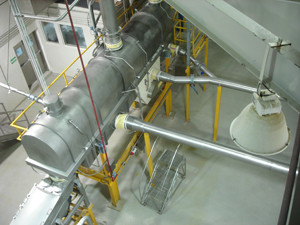
Application
Fluid beds are used for cooling or drying material. Product is gravity fed onto an enclosed horizontal perforated plate. Hot or cold air introduced below the plate blows through the product to create a fluidized bed of material. The fluid bed dryer (or cooler) oscillates in a manner which transports the material to a weir at the discharge end of the plate. The air exhausts through top mounted take off ducts to one or more dust collectors or cyclone separators.
Hazard
If the material being handled by a process is combustible, then the dust it generates is likely to be explosive, which can cause a combustible dust explosion. Fluid bed dryers/coolers generate a potentially explosive dust/ air mixture as the material being dried or cooled is fluidized by the incoming air. Under these conditions, an ignition source is all that is required to trigger an explosion. This can be provided by incoming burning particles from upstream equipment such as other dryers. Material adhering to the walls of the dryer or material building up at the internal weir can also auto-ignite providing the ignition for an explosion.
Protection System Description
Fluid bed dryers/coolers are commonly located inside the plant making protection by explosion relief venting impractical. Their geometry also makes venting difficult to accomplish. An explosion suppression system provides the solution. In such a system, explosion pressure detectors mounted on the fluid bed dryer/cooler detect the pressure excursion from an incipient explosion. The detectors transmit a signal to a control panel, which triggers high rate discharge extinguishers while simultaneously shutting down the process. The extinguishers mounted on the dryer/cooler rapidly discharge suppressant in an effort to quench the fireball before maximum pressures are reached. Isolation extinguishers mounted on the inlet duct and dust extraction ducts mitigate explosion propagation to interconnected process equipment.


